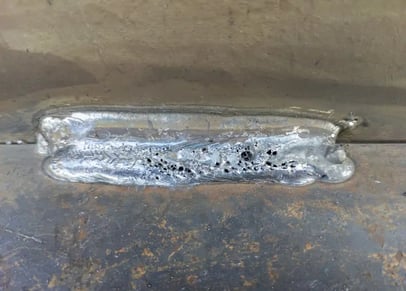Comprehending What is Porosity in Welding: Causes and Solutions
Comprehending What is Porosity in Welding: Causes and Solutions
Blog Article
Understanding Porosity in Welding: Checking Out Causes, Effects, and Prevention Strategies
As professionals in the welding industry are well mindful, recognizing the reasons, effects, and avoidance techniques related to porosity is vital for accomplishing robust and trustworthy welds. By diving right into the root triggers of porosity, examining its destructive results on weld top quality, and exploring reliable avoidance strategies, welders can boost their expertise and skills to create top quality welds regularly.
Typical Root Causes Of Porosity
Porosity in welding is mostly caused by a combination of factors such as contamination, incorrect protecting, and inadequate gas protection throughout the welding process. Contamination, in the kind of dust, oil, or corrosion on the welding surface, produces gas pockets when warmed, bring about porosity in the weld. Improper protecting happens when the protecting gas, typically used in procedures like MIG and TIG welding, is unable to fully secure the molten weld pool from responding with the surrounding air, resulting in gas entrapment and subsequent porosity. Furthermore, poor gas protection, frequently due to inaccurate circulation prices or nozzle positioning, can leave components of the weld unsafe, allowing porosity to create. These aspects jointly contribute to the formation of gaps within the weld, weakening its integrity and potentially triggering structural concerns. Recognizing and dealing with these common reasons are important action in stopping porosity and ensuring the quality and strength of welded joints.
Results on Weld Quality
The visibility of porosity in a weld can considerably endanger the general high quality and stability of the welded joint. Porosity within a weld develops voids or tooth cavities that compromise the framework, making it much more at risk to breaking, corrosion, and mechanical failing.
Additionally, porosity can prevent the effectiveness of non-destructive screening (NDT) techniques, making it testing to discover other defects or gaps within the weld. This can lead to substantial safety and security issues, particularly in critical applications where the structural integrity of the bonded elements is vital.

Avoidance Techniques Introduction
Given the damaging influence of porosity on weld top quality, efficient avoidance techniques are crucial to keeping the architectural honesty of welded joints. Furthermore, weblink picking the suitable welding specifications, such as voltage, existing, and take a trip speed, can help minimize the threat of porosity development. By incorporating these prevention methods right into welding methods, the event of porosity can be significantly minimized, leading to stronger and extra trustworthy welded joints.
Value of Correct Protecting
Proper shielding in welding plays a vital function in avoiding climatic contamination and guaranteeing the stability of welded joints. Securing gases, such as argon, helium, or a blend of both, are typically made use of to protect the weld swimming pool from reacting with components in the air like oxygen and nitrogen. When these reactive elements come right into call with the hot weld swimming pool, they can cause porosity, bring about weak welds with decreased mechanical residential properties.

Poor securing can lead to different problems like porosity, spatter, and oxidation, endangering the structural integrity of the welded joint. Adhering find out this here to proper shielding techniques is necessary to produce top notch welds with marginal issues and make sure the long life and dependability of the bonded components.
Monitoring and Control Methods
Just how can welders effectively check and manage the welding procedure to make certain optimal outcomes and avoid defects like porosity? By constantly monitoring these variables, welders can identify discrepancies from the excellent conditions and make immediate modifications to protect against porosity development.

In addition, executing proper training programs for welders is vital for checking and controlling the welding procedure effectively. What is Porosity. Informing welders on the importance of preserving consistent parameters, such as correct gas securing and take a trip view website speed, can help prevent porosity problems. Routine assessments and certifications can additionally make certain that welders are proficient in surveillance and regulating welding procedures
In addition, making use of automated welding systems can boost monitoring and control capacities. These systems can exactly manage welding specifications, reducing the chance of human error and making certain constant weld top quality. By integrating innovative monitoring innovations, training programs, and automated systems, welders can efficiently monitor and manage the welding process to lessen porosity issues and attain top quality welds.
Conclusion

Report this page